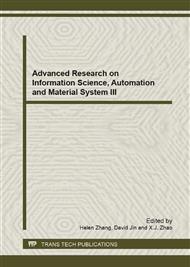p.282
p.287
p.291
p.295
p.300
p.304
p.308
p.312
p.319
Study on Based Motion in Improved Radon Transformation with Mechanics Properties
Abstract:
Mechanics properties of human body mechanical movement have a lot of initiative and variability, especially sports technical movement is the day after tomorrow, spontaneous or consciously form. To a video clip, mechanics properties of human motion reflect the changes which are the important characteristics of the gradual progress in video. If we want to describe the overall content of the video, the motion properties are an essential respect. An improved radon transformation method of feature extraction for human behavior identification is designed in order to solve the sensitivity of the scaling and translation invariant of conventional radon transformation. It deduces the process of the improving method to keep the scaling and translation invariant. The experimental results show that the improving method is low computation and higher recognition rate. Also, it enhances the robustness of feature extraction.
Info:
Periodical:
Pages:
300-303
Citation:
Online since:
June 2013
Authors:
Price:
Сopyright:
© 2013 Trans Tech Publications Ltd. All Rights Reserved
Share:
Citation:


